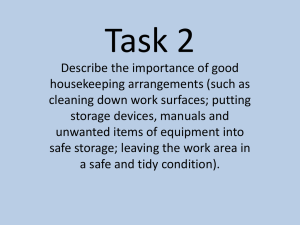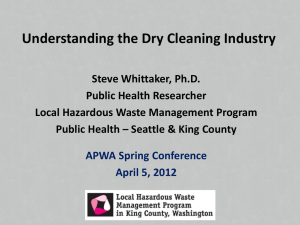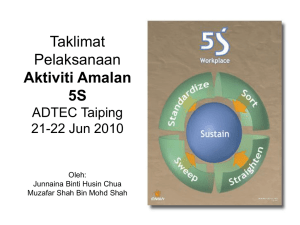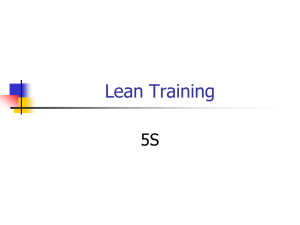Cleaning for Healthy Schools
advertisement
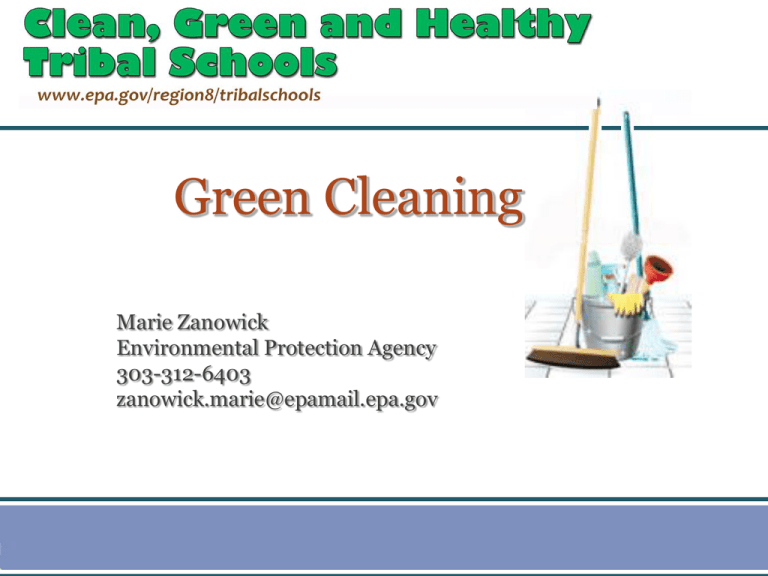
Green Cleaning Marie Zanowick Environmental Protection Agency 303-312-6403 zanowick.marie@epamail.epa.gov Marie Zanowick Marie is a creative environmental engineer with 25 years experience working for the U.S. EPA. With her background in biology, public health, engineering and biomimicry, regulatory and facilitation, she assists governments and industry in developing and maintaining sustainability management systems as they find ways to reduce pollution and move toward sustainability. Green Cleaning Tribal School Staff & Administrators will: n n n understand why it is important to use green cleaning products; identify and select green cleaning products; apply green cleaning techniques. Why Green Cleaning? n Schools house vulnerable people in heavily used, densely occupied spaces n One-half of our schools have problems with indoor environmental quality (IEQ). n Children are more vulnerable to toxins Region 7 Wells Band NV, EPA Children Are at Greater Risk from Toxic Chemicals Children: n n n n n n n eat more food breathe more air drink more water play closer to the ground engage in more hand-to mouth activity cannot detoxify or process toxins as adults do have rapidly developing and more sensitive systems Cleaning Staff are at Risk from Toxic Chemicals n n n n n n One custodial worker uses 194 pounds of chemicals each year 25% are hazardous substances Custodial workers experience one of the highest rates of occupational asthma 6 of 100 are injured each year 20% are serious burns to the eyes or skin 12% result from inhaling chemical vapors Health Impacts and Indoor Environmental Quality n Asthma n Allergies and Sensitivities n Sick Building Syndrome and Building Related Illnesses n Absenteeism, Reduced productivity & Absenteeism Routes of Entry Inhalation 4 Absorption 4 Ingestion 4 Injection 4 Cleaning, Indoor Environmental Quality (IEQ) and Health Ingredients in common cleaning products linked to: n n n n n n New cases of asthma and triggering asthma episodes Harm to brain, nervous system, reproductive organs, kidneys and liver Irritated eyes and headaches Breathing problems and illnesses Disruption by acting like hormones Cancer The Solution: Cleaning for Healthy Schools Cleaning that protects public health, without harming the health of children, personnel and the environment. Health First! Cleaning for Healthy Schools Principles 1. Keep the dirt out 2. Use less-toxic, third-party certified, all purpose cleaners, paper products and hand soaps 3. Update and maintain equipment 4. Cleaning with all-purpose cleaners to removes most germs - disinfect only in target areas. 5. Breathe easier – clean doesn't have an odor Key Elements for Green Cleaning of Schools Work with the staff at your school who are responsible for purchasing and using cleaning supplies: 1. Evaluate current cleaning problems, products, methods 2. Develop a pilot project to test 1-2 products 3. Train staff with new products/methods 4. Request feedback on how the pilot is going 5. Phase in more “green” cleaning products Key Elements for Green Cleaning of Schools Once you develop a green cleaning chemical program: 1. Track success: (school nurse visits, attendance) 2. Reward staff for participating 3. Promote success to the public 4. Adopt a local district policy 5. Educate all staff on the new policy Healthier Cleaning Solutions Low-odor Less-toxic Cost-neutral Reduce sources of indoor pollutants Improve Indoor Environmental Quality Recommended by US EPA's Tools for Schools www.epa.gov/schools Selecting Safer Products What to look for on an MSDS 4 Volatile Organic Compounds - 1% or less 4 pH between 5 – 9 4 Avoid aerosols, corrosives, that cause eye or mucous membrane damage, burn the skin 4 Ingredients that cause cancer, mutations and birth defects Highest Risk Products Product Acid toilet bowl cleaner Carpet spotter General purpose cleaner Floor finish stripper Baseboard stripper Problem Ingredient (s) Health Effects Hydrochloric acid Burns eyes & skin Can cause blindness Hydrochloric acid Poisonous Causes cancer Flammable Butoxyethanol Sodium hydroxide Ethanolamine Butoxyethanol Sodium hydroxide Ethanolamine Butoxyethanol Sodium hydroxide Ethanolamine Burns eyes and skin Poisonous Burns eyes and skin Poisonous Burns eyes and skin Poisonous Third Party Certifiers: Find and Use Certified ‘Green’ Products Ads and labels not always reliable Rely on 3rd party certifiers to evaluate all-purpose cleaners and other products: – Hand soaps (not antibacterial) – Paper products – Chlorine-free, recycled – Tissue & towels on large rolls Better Cleaning Equipment Updated equipment to reduce particulates in air Dirt-grabbing walk-off mats inside and outside entrances Microfiber cloths and mops HEPA vacuums or microfiber mops High-filtration vacuum attachments on floor-care equipment Clean for Health: Best Practices • • • • • • Keep dirt out – reduce dust by vacuuming Leave classrooms ready to clean Clean from the top down Select durable easy clean flooring; Maintain/replace carpets Clean up spills right away Germ Control Hierarchy n n n n All-purpose cleaner and friction remove most germs Sanitize food prep areas and child care areas Disinfectants where required and in high risk areas Know the law and clean first Implementation Challenges? Teachers or children supplying cleaning products Excessive demand for ‘disinfection’ Classrooms not ready to cleaned Belief that green products are more expensive or not as effective What are challenges in your school? Green Cleaning Revolution We have saved a substantial amount of money by going to green cleaning. – Facilities Manager I don’t have the dry throat and headache anymore from all the odors & chemicals. – Custodian The use of inhalers has decreased at school. – Nurse My child's rashes are gone and she is healthier during the school week. – Parent What are your regional policies or issues? Policies that requiring use of ‘green’ products? Policies requiring IAQ/IEQ programs in schools? Organizations supporting safer chemical or toxic use reduction? Are environmental, health, parent, labor, and education associations and advocates united? What are next steps towards green cleaning and chemical policy reform in your school? For More Information www.cleaningforhealthyschools.org www.epa.gov/schools Marie Zanowick Environmental Protection Agency 303-312-6403 Zanowick.marie@epamail.epa.gov Green Cleaning Marie Zanowick Environmental Protection Agency 303-312-6403 zanowick.marie@epamail.epa.gov





